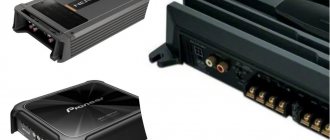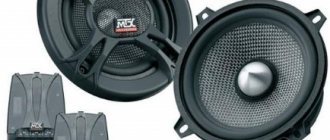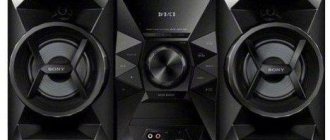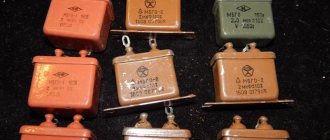Not every car has a built-in sound system, especially if we are talking about basic cars. But even the presence of standard speakers does not mean that they sound high quality. Therefore, car enthusiasts ask a logical question: “what speakers to put in the car for good sound?”
This article is about how to choose the right speakers for a car, and which speakers you should buy in 2022.
Types of car speakers
Based on the method of execution, car speakers are divided into 3 types:
- Wideband acoustics. This is one speaker responsible for reproducing the entire frequency range. Acoustics of this type are the most affordable; manufacturers of inexpensive cars build them into their cars. A wideband speaker is suitable for listening to radio broadcasts or soft music.
- Coaxial acoustics. This is an advanced acoustics system that consists of several speakers located in one housing. A separate speaker is responsible for reproducing each frequency range (low, mid, high). This improves the quality of the audio system and expands the range of frequencies it reproduces. Coaxial models produce decent sound for reasonable money.
- Component acoustics. Today this is the most advanced and, of course, expensive speaker system. The secret to the success of such speakers is that each speaker (woofer, midrange, tweeter) is housed in a separate housing. At the same time, budget component acoustics are equipped with a pair of “midbass” and “tweeters”. Whereas in sets of expensive speakers there is a subwoofer (passive or active) and a crossover.
Level four. Complete replacement of the standard system
There are situations when you are not satisfied not only with the sound of the standard system, but also with the functionality of the head unit itself. In this case, thoughts about replacing it become especially annoying. But this cannot always be done with small forces.
Initially, this Honda was equipped with a standard head unit integrated into the dashboard. Using a non-standard panel, it was possible to install a new head unit of standard DIN sizes
First of all, take a close look at what the standard head unit is. If it has its own display, and all audio system controls are not connected to other car systems (climate control, on-board computer, etc.), then it can most likely be safely removed, while all other systems will remain unaffected.
Don't let the original shape and size of the standard GI confuse you. Firstly, there are now many alternative head units that are produced for specific car brands and fit into the panel using the pin-to-pin principle - the seats and connectors are completely the same. Or you can use an adapter frame to install a standard 1DIN or 2DIN size device and an adapter from a standard connector to a standard ISO. They are produced by many manufacturers, so choosing the right set is usually not difficult. As a last resort, no one has canceled the custom solution either.
If the standard head unit has many standard functions, then replacing it is a very difficult task; there are not simple solutions for every car. Pictured is an Alpine kit designed specifically for Mercedes
But if the standard “head” is combined with other car systems, then it’s more complicated. It is far from a fact that there is an alternative head unit for your car. In this case, the approach will be individual, and most likely costly.
This McIntosh became the head of the new audio system, and a mounting frame was made especially for it. All that remains of the standard system is the head unit, which now serves as the second most important source
But there is another option. It looks quite extravagant, but sometimes the only way to organize a truly high-quality audio source in a car is to leave the standard head unit unchanged and install a second one. In this case, it becomes the main one in the system, and the audio system is built from it. The standard one is shifted from the role of the main one in the system and becomes additional - its outputs are connected to the AUX inputs of the new head unit.
How to choose the right speakers for your car: selection criteria
To choose the right speakers for your car, professionals recommend taking these criteria into account:
- Acoustic band. Bandwidth refers to the width of the range and the number of speakers used to separate music into specific frequencies. A simple option is single-way speakers. Accordingly, the higher the bandwidth, the better the quality, clarity and detail of the sound. For example, four-way speakers are equipped with 15-20 speakers, where each reproduces its own frequency range.
- Number and sizes of speakers. Without delving into theory, the rule is this: the larger the size of the speaker, the better it reproduces low frequencies (bass). Conversely, small speakers (or tweeters) produce high frequencies. So, those who need an extended frequency range and sound without distortion need an acoustic system consisting of: 2 low-frequency, 2 mid-frequency, and 2 small speakers for reproducing high frequencies. This is a recommended set only, so the number and composition of speakers may vary.
- Frequency range. This parameter determines what frequencies the speakers play music at. The wider the range, the better the sound quality at its lower and upper boundaries. For a mid-level car speaker, the frequency range is 30-25000 Hz. If audiophile Hi-Fi sound is required from the speakers, the frequency range should not be “narrower” than 27-37000 Hz.
- Rated and peak power. The first indicator means the power at which the speaker can operate for a long time without distorting the sound or being damaged. The second parameter characterizes the maximum permissible sound level that the acoustics produce for a short time. The higher the rated and peak power, the louder and richer the sound the car speaker produces.
The best car audio brands
There are dozens of companies producing acoustics for cars. Among them, these top five stand out:
- JBL;
- Pioneer;
- Phantom;
- Hertz;
- Morel.
Companies produce both amplified and standard speakers.
Level two. Replacing standard speakers
This is where you need to be very careful. This is a field with a rake; you can’t run with your eyes closed. This upgrade option is not always applicable. If you replace only the speakers and leave everything else, then it is far from a fact that the system will “sing.” Moreover, in some cases the result may be completely negative. Although the standard audio system itself is not of a high class, everything in it is matched to each other and balanced.
It is clear that the audio system is far from a priority element when designing a car, but sometimes the methods for installing standard speakers are simply surprising. The photo shows a standard BMW speaker, which was simply attached to the inside of the upholstery and covered with a light casing
One of the tricks that automakers resort to is reduced acoustic impedance. In general, the most common acoustics in car audio are 4-ohm ones, but in “standard” speakers they often use 2-ohm ones. All in order to boost the dead standard amplifier and slightly increase the volume headroom. Replace these speakers with more conventional 4-ohm ones and you get a quiet system, and any attempts to increase the volume will be accompanied by an increase in distortion.
But that’s okay, there are plenty of aftermarket acoustics with 2-ohm ones. Don't step on another rake - a corrected signal. This, by the way, is one of the “tricks” of many branded standard systems - it’s not the components that are better, but correction that compensates for the features of cheap speakers and the shortcomings of their acoustic design. Replace the dynamics in such a system, and such a correction will no longer be appropriate.
But there is no need to be scared and completely discard this option. Today you can find many acoustic kits that are tailored specifically for certain brands and models of cars. Mainly for European ones, in this part of the world such an upgrade is most in demand.
The video demonstrates the ease of upgrading a standard audio system by simply replacing the OEM speakers with a set specially designed for a specific car brand:
FAQ
- What size of speakers is best to install in a car ? Body size is the main parameter when choosing car speakers. The most widespread models in the world are 10-, 13- and 16-centimeter models. Less common are oval columns measuring 16x22 cm (6x9 inches).
And the last type is tweeters. These are small speakers that reproduce high frequencies. For installation in the front doors (to the front), speakers of 16 cm are suitable (or 16.5 cm, if the regular space allows). If you plan to place the device in a torpedo, a 10-centimeter model will do. “Ovals” are usually installed on the rear shelf. Rear pancakes are usually installed to replace the subwoofer. Therefore, if a person does not want to install a sub in the car, but does not plan to put up with “cut-down” low frequencies, then this size is suitable. The advantage of “ovals” is that these speakers are universal, because They can also sound clear at mid frequencies. But the emphasis, of course, is on the bass.
Level one. Noise insulation
Yes, yes, this is the very first point for any upgrade of a standard audio system. If you want to listen to music, first of all get rid of unnecessary sounds. By the way, we are talking not so much about outside noise as about body noise. Look at the home speaker. Durable body, devoid of overtones. Sound emits only what should emit sound, and what should not be held monolithically. Now take a look at where and how any car speaker is installed and what the housing is for it. Most often it is mounted on some kind of metal panel, and in the worst case, even on plastic upholstery. And the body of such a “column” is a door or some kind of body niche. Tough, and that's all. By the way, in the literal sense of the word.
The easiest way to improve the acoustic operating conditions of speakers and get rid of unnecessary resonances and other metallic sounds is to use vibration-damping materials. They are usually made from bitumen or rubber, often with some additives. Their main feature is high internal viscosity. Basically, these are just sheet materials that are cut right on site and carefully rolled onto the metal. But sometimes such materials come in the form of mastics.
Treatment with vibration-damping materials eliminates metallic sounds and improves the operating conditions of installed speakers
Vibration-damping materials are heavier and more rigid, more effective, but they are also harder to work with, so not all craftsmen like them. Thinner and lighter ones are easier to work with, but their effect is not so high. The optimum is usually somewhere in the middle.
Various kinds of lightweight foam and fibrous materials can be considered only optionally; they work somewhat differently and do not have much effect on the absorption of metal vibrations.
Main factors influencing the quality of speakers
How to choose speakers for your car radio
What does everyone want when considering purchasing speakers? Of course, achieve powerful and, most importantly, clear sound in your salon. Naturally, the quality of the speakers alone will not be enough for this, because many factors influence surround sound, but still. High-quality speakers, selected correctly and in accordance with the rules, are the basis of the basics. So, in order to get clear and spacious sound, you should take into account at least these main factors:
- location of speakers in the car interior;
- high-quality noise and vibration insulation;
- speaker cable and much more.
Column types
The first question that will be asked to a buyer in an acoustics store will be the following: which speakers do you prefer to purchase, coaxial or component?
Coaxial speakers
Three-way coaxial speakers
Coaxial speakers are devices that are equipped with several speakers and they differ accordingly. In other words, it is customary to classify coaxial speakers as 2-way, 3-way, and so on. This will mean that they have two or three speakers built in, respectively.
Note. Coaxial speakers are made primarily in order to save space and reduce the cost of the assembly process.
One coaxial speaker is capable of playing the entire range of sounds, and to find out how many bands there are in it, you should count the number of speakers attached to the leg.
Component speakers
Component speakers
Component speakers are a device where high-frequency speakers are located separately from mid-range and low-frequency speakers. These are already completely professional speakers that allow you to parse a melody into its components and enjoy the music to its fullest.
Note. Even an inexperienced person who listens to music through these speakers will be able to recognize the playing of individual musical instruments, everything is so effectively thought out in them. Needless to say, the sound quality in these speakers is much higher than in coaxial ones, but they also cost much more.
Component speakers are designed to reproduce sound within a specific frequency range. The sound quality is always at the proper level with these speakers, and the speakers must be installed according to the following rules. So:
- If the speakers selected are small, then they reproduce only high frequencies (this is described in detail below). For this reason, you should try to place them so that the sound goes directly to the driver or passenger. If you can mount them on the front panel or on a rack, that would be ideal.
- You can’t install larger speakers in front (although this is possible), but they reproduce mid and low frequencies. They can be easily installed in the car doors or behind them, directly on the glass shelf. In principle, there is no difference in the placement of large speakers.
Speaker size
Of course, this is the second most important question that a store salesperson will ask. It is usually not possible to install huge dimensions in a car, and every owner should remember this. In addition, if you purchase speakers larger than the standard ones intended for this car by the manufacturer, who has prepared a place for them in advance, you will have to make modifications.
Note. You need to know that speakers measuring 10-13 cm (4-5 inches) diagonally are capable of reproducing only high frequencies. But speakers measuring 16-17 cm (6-6.5 inches) diagonally reproduce low frequencies in addition.
We can say that this is the main difference in size. The speakers are large, and in any case they will reproduce sound better, but this is not an axiom.
Power
How to choose speakers for a car radio
This is probably the most important parameter for amateurs who imagine that they understand music. But we hasten to disappoint them. It turns out that the power of the speakers in itself cannot act as a quality characteristic. There is even a rule according to which this very power must be selected, otherwise you cannot expect clear sound. So, according to the rules, the power parameter should not be less than the power of the car radio. This is already an axiom that you can’t argue with. Loss of sound quality and much more is the result of incorrect selection of speaker power. On the other hand, the power of the speakers should not significantly exceed the parameters of the car radio, as this will also not lead to anything good. Power, as such, is usually divided into:
- rated power;
- maximum power;
- peak power.
The smallest of the three is, naturally, the rated power, but it is also the most correct. Some unscrupulous manufacturers, in order to attract clientele, indicate maximum or peak power in the passport data. In reality, a competent buyer who knows about the rated power should look for its value in that data, as the determining and only correct one.
Note. It is the rated power that determines the limits within which you can listen to music loudly and for a long time.
It is not uncommon for a speaker with a lower power rating to be able to produce the same sound level as a more powerful speaker (provided its sensitivity is higher). Power cannot act as the only criterion for high-quality sound, because you can improve the performance in another way: by installing a speaker system with a resistance of 2.5-3.5 Ohms. In addition, the amplifier, which must be adapted to the power, is of great importance, otherwise it will not be possible to avoid the imminent failure of the equipment, no matter how expensive it is.
Acoustic design
This is one of the important factors affecting sound reproduction. There are many varieties of acoustic design, but it is customary to divide it into two main ones: unloaded and loaded.
Note. Unloaded design implies limiting the vibrations of the diffuser by the rigidity of the suspension. As for the loaded design, it implies limiting vibrations not only by the rigidity of the suspension, but also by radiation resistance.
In addition, it is customary to divide acoustic design into single- and double-acting systems. The first is characterized by sound emission from only one side of the diffusers, and the second - from both sides. Now let's look at the most popular types of acoustic design:
- A “closed box” is a speaker housing that is covered with sound-absorbing components that effectively dampen waves. This type of acoustic design is ideal for those music lovers who put high-quality playback first, or, in other words, so that there is a slight loss of sound pressure and all this is compensated by the simplicity and small size of the speaker.
Speakers in “closed box” acoustic design
- A bass reflex is a housing in which a special hole is made. It is responsible for the connection between external and internal air. Ideal for music lovers who prefer to listen to sound in two blocks at the same time.
Bass reflex
- Free acoustic design, implying the use of a large body acting as a screen.
Subwoofer in free design
Other factors
Component speakers built into the car door
In addition to the types of speakers we have analyzed, their sizes and power, there are other factors that many perceive as trifles. But let’s not forget that sometimes it’s the little things that decide the outcome of an event:
- Sensivity – or the input sensitivity of the speakers. The higher this parameter is, the better. Again, not everything is so simple here and in order not to confuse anything, we remember that the recommended indicator of this sensitivity should be within 92.
How to choose speakers for your car radio
- FS is already a resonant purity of reproduction, which also acts as a separate factor influencing the sound. The lower the value, the better and the speakers will be able to produce deeper bass. The normal and recommended value in this case is the limit of 60-75.
- The range of reproduced frequencies is an indicator that indicates frequency boundaries. Recommended value is +/- 3 dB.
- QTS – or sound quality factor. This factor must also be carefully paid attention to. The fact is that if the speakers are installed in the car door (which is fashionable today), then the Q value of the speakers should exceed 0.6. Otherwise, there can be no talk of any sound quality.
Note. Normal correct sound should reach the person in front. This is a law of physics, but there is no such option in a car to install speakers in front.
Some owners, however, manage to do this by making fundamental design changes, modifying the pillars and dashboard, but not everyone can afford it. In this regard, the sound from the speakers installed in the door will come from the side and to the feet. Therefore, the quality factor must be assessed correctly.











